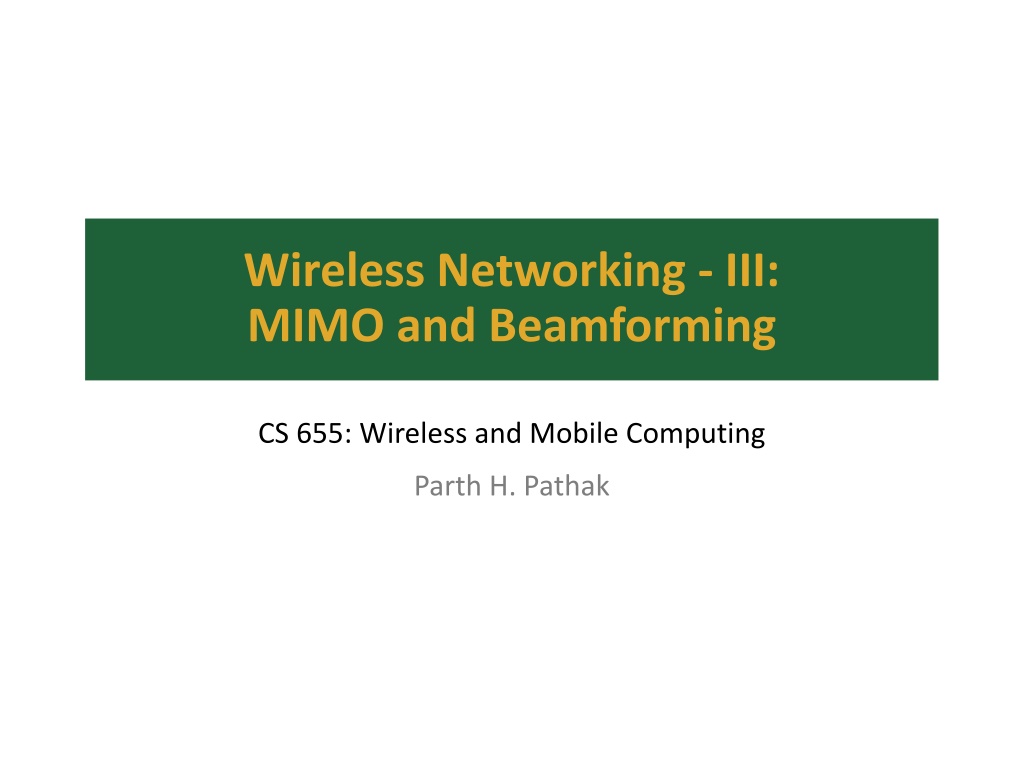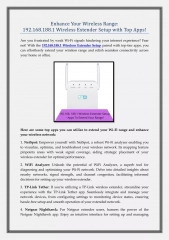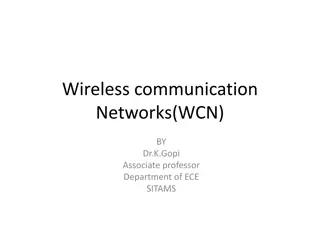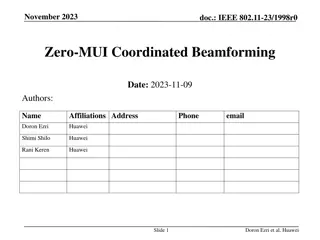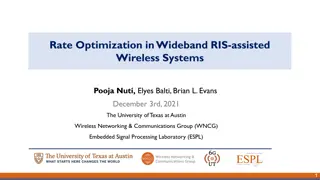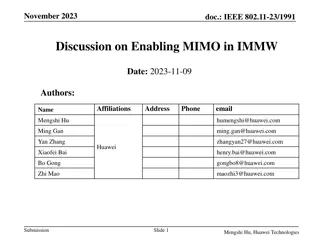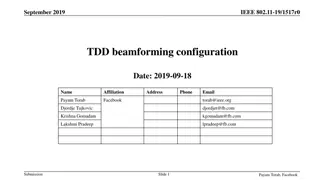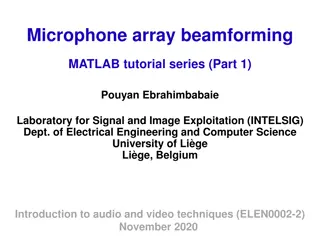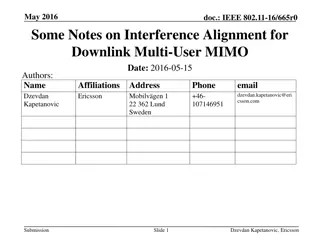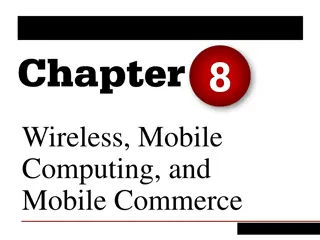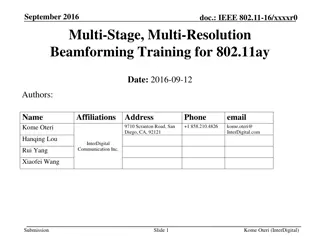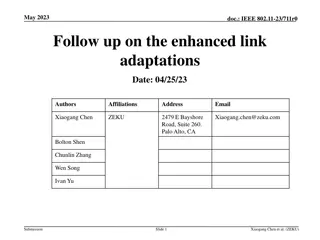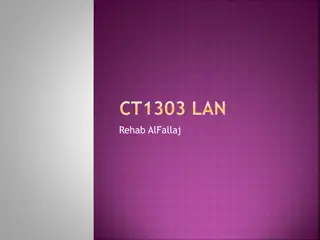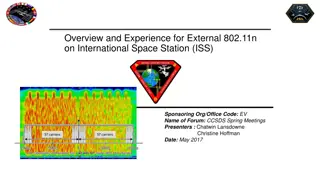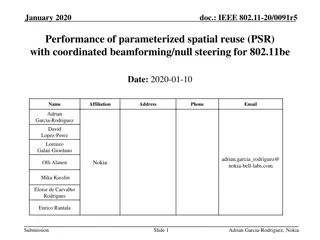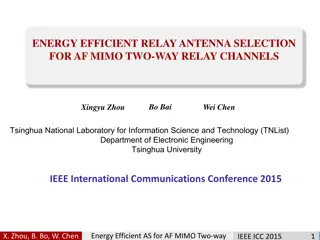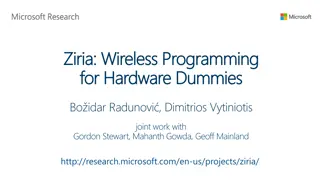Wireless Networking - III: MIMO and Beamforming
The content delves into MIMO (Multiple Input Multiple Output) technology, beamforming, and wireless network capacity enhancement. It discusses 802.11 standards, wireless channel capacity, methods to increase capacity, multiple antenna systems, and the implications of increasing SNR and transmission power on network performance.
Download Presentation

Please find below an Image/Link to download the presentation.
The content on the website is provided AS IS for your information and personal use only. It may not be sold, licensed, or shared on other websites without obtaining consent from the author.If you encounter any issues during the download, it is possible that the publisher has removed the file from their server.
You are allowed to download the files provided on this website for personal or commercial use, subject to the condition that they are used lawfully. All files are the property of their respective owners.
The content on the website is provided AS IS for your information and personal use only. It may not be sold, licensed, or shared on other websites without obtaining consent from the author.
E N D
Presentation Transcript
Wireless Networking - III: MIMO and Beamforming CS 655: Wireless and Mobile Computing Parth H. Pathak
802.11 PHY and MAC 802.11 PHY and MAC MAC: 802.11b 802.11a 802.11g 802.11n 802.11ac CSMA/CA and wideband medium access Frequency 2.4 GHz 5 GHz 2.4 GHz 2.4/5 GHz 5 GHz Channel width 20/40 MHz 20/40/80/ 160 MHz 20 MHz 20 MHz 20 MHz PHY-I: OFDM, DSSS/CCK PHY DSSS/CCK OFDM OFDM OFDM OFDM and modulation MIMO & beamform ing No No No Yes Yes Max. data rate ~6933 Mbps PHY-II: 11 Mbps 54 Mbps 54 Mbps 600 Mbps MIMO and beamforming 2
Wireless networking Wireless networking - - I I Today s agenda MIMO overview MIMO rate adaptation MIMO energy consumption Beamforming MU-MIMO and user selection 3
Wireless Capacity Wireless Capacity Wireless channel capacity Shannon s theorem How can we increase the capacity (achievable data rate/speed) of a wireless link/channel? ? = ? log21 +? B = bandwidth (Hz) S/N = Signal to noise ratio (SNR) ? How about we simply increase channel bandwidth (B)? Problem: spectrum scarcity Nearly impossible to find usable bandwidth, frequency 4
Wireless Capacity Wireless Capacity Wireless channel capacity Shannon s theorem How can we increase the capacity (achievable data rate/speed) of a wireless link/channel? ? = ? log21 +? B = bandwidth (Hz) S/N = Signal to noise ratio (SNR) ? How about increasing SNR? Increase the signal power to increase S? SNR (dB) C/B (bits/sec./Hz) The quest for more wireless channel capacity by far the most important research problem 0 1 Problem: increasing transmission power will also increase your interference to other links 5 2.19 10 3.46 Increase spectral efficiency -> bits/sec/Hz 15 5.03 20 6.66 More channel sharing, more collisions, lower speeds 25 8.31 30 9.97 5
Multiple Antenna Systems Multiple Antenna Systems Wireless devices can be equipped with multiple antennas Can multiple antennas increase the achievable capacity? Multiple antenna systems Early research in 1990s showed huge capacity gains Practical systems developed in early 2000s Commonly used in current WiFi, LTE, WiMax systems Capacity gains If only one end point (Tx or Rx) has multiple antennas o Linear increase in SNR without increasing transmission power If both Tx and Rx have multiple antennas o Linear increase in capacity for every pair of Tx, Rx antenna 6
MIMO MIMO Tx Rx Tx Rx MISO (Multiple Input Single Output) SISO (Single Input Single Output) All antenna utilize the same frequency and channel Tx Rx Tx Rx SIMO (Single Input Multiple Output) MIMO (Multiple Input Multiple Output) 7
Spatial Diversity Spatial Diversity Tx Rx Paths between antennas Multiple antennas enable multiple paths between Tx and Rx These paths observe independent fading Spatial paths Independent paths between antennas can be exploited to increase gain Shannon s capacity Capacity gain through spatial diversity/freedom 8
Channel Matrix Channel Matrix noise Received signal ? Tx Rx ? = ?? + ? SISO Transmitted signal Channel matrix/vector OFDM with S subcarriers, ? = {C1,C2,C3, Cs} where ??= ????? Phase Amplitude 9
Channel Matrix Channel Matrix ?11 ?12 Tx Rx ? = ?? + ? ?13 H is a M x N x S matrix SIMO (Single Input Multiple Output) Where M = number of Tx antenna N = number of Rx antenna S = number of subcarriers OFDM with S subcarriers, ?mn= {C1,C2,C3, Cs} 10
MIMO Techniques [1] MIMO Techniques [1] How to take advantage of multiple antennas at Tx, Rx or both? Multi-antenna systems MIMO MISO/SIMO Selection Combining (SEL) Maximal-Ratio Combining (MRC) Spatial multiplexing Direct-mapped MIMO Precoded MIMO 11
SIMO SIMO ?11 MIMO notation (M x N) where M is number of transmit antenna N is number of receive antenna ?12 Tx Rx ?13 1 x 3 MIMO SIMO Single Input Multiple Output Each receiving antenna receives a copy of the transmitted signal Signal variation can be measured at the receiver using the H matrix How to combine the received signal at the receiver? 12
SIMO SIMO Receiver diversity techniques ?11 ?12 Tx Rx ?13 1 x 3 MIMO 1. Selection Combining (SEL) Pick the antenna with the strongest SNR Used in early generation 802.11a/g devices Does not take advantage of other available antennas 13
SIMO SIMO Receiver diversity techniques ?11 ?12 Tx Rx ?13 2. Maximal Ratio Combining (MRC) 1 x 3 MIMO Use signal available through each Rx antenna Signal combining o Weight the signal of each antenna using its SNR o Amplify useful signal and reduce noise o Sum the weighted signals Challenges? o Each signal received on different path (separate Hmn) o Phase is different for each received signal o Align the phase through a reference before combining the signal 14
SEL vs. MRC SEL vs. MRC [1] ? ? Tx Rx ? 1 x 3 MIMO 802.11n link with 1x3 configuration Each Rx antenna (A, B, C) observes independent channel fading SEL selects B best SNR MRC (for AB and ABC) substantially improves the SNR MRC more complex to implement but higher performance gain compared to SEL 15
MISO MISO Transmit diversity techniques Tx Rx 1. Selection Combining (SEL) Pick the best (highest SNR) antenna to send the signal MISO (Multiple Input Single Output) 2. Maximal Ratio Combining (MRC) Transmitter precodes the signal o Apply more power to the antenna path which provides higher SNR o Delay the phase in such as way that transmitted signal from all antennas combine constructively at the receiver How to know which antenna is the best? 16
MISO MISO Transmit diversity techniques Requires feedback Tx Rx MISO (Multiple Input Single Output) Channel feedback from receiver Transmitter sends data to receiver Receiver observe the channel matrix for each spatial path Receiver sends the measured channel matrix back to transmitter Transmitter uses the feedback for SEL or MRC Reciprocity Transmitter measures the channel matrix when it receives a packets from receiver Calibration required to account for differences (different hardware, number of antennas) 17
MIMO and Capacity MIMO and Capacity [1] MIMO technique Capacity (bits/second) SISO ? = ? log21 + ??? 18
MIMO and Capacity MIMO and Capacity [1] MIMO technique Capacity (bits/second) SISO ? = ? log21 + ??? SIMO (1 x N) Receiver diversity ? = ? log21 + ? ??? 19
MIMO and Capacity MIMO and Capacity [1] MIMO technique Capacity (bits/second) SISO ? = ? log21 + ??? SIMO (1 x N) Receiver diversity ? = ? log21 + ? ??? MISO (M x 1) Transmit diversity ? = ? log21 + ? ??? 20
MIMO and Capacity MIMO and Capacity [1] MIMO technique Capacity (bits/second) SISO ? = ? log21 + ??? SIMO (1 x N) Receiver diversity ? = ? log21 + ? ??? MISO (M x 1) Transmit diversity ? = ? log21 + ? ??? MIMO (M x N) ? = ? log21 + ? ? ??? Transmit and receiver diversity 21
MIMO and Capacity MIMO and Capacity [1] MIMO technique Capacity (bits/second) SISO ? = ? log21 + ??? SIMO (1 x N) Receiver diversity ? = ? log21 + ? ??? MISO (M x 1) Transmit diversity ? = ? log21 + ? ??? MIMO (M x N) ? = ? log21 + ? ? ??? Transmit and receiver diversity MIMO (M x N) Spatial multiplexing ? = min M,N B log21 + ??? 22
MIMO MIMO M x N antenna systems Diversity techniques simply increase SNR Tx Rx MIMO (Multiple Input Multiple Output) Spatial multiplexing Use the independent spatial paths enabled by M x N antennas to send parallel streams of data (referred as spatial streams) Each spatial stream carries different data All spatial streams occupy same frequency channel and time Number of spatial streams can be min(M, N) Parallel spatial paths over the same frequency channel Min(M, N) fold increase in capacity ? = min M,N B log21 + ??? 23
MIMO spatial multiplexing MIMO spatial multiplexing Direct Mapped MIMO Transmitter divides the transmit power equally among all spatial streams Each spatial stream transmitted out of one transmit antenna ? = ?? + ? 802.11n/ac devices use training fields at the start of the frame Receiver uses the training fields to estimate H Use H to decode the transmitted data over each stream Two types of common receivers o Zero forcing (ZF) receivers o Minimum Mean Square Error (MMSE) receivers 24
MIMO spatial multiplexing MIMO spatial multiplexing Precoded MIMO Direct mapped MIMO makes decoding to be completely receiver s responsibility In precoded MIMO, transmitter can use the channel matrix to precode the data before transmitting over the antennas Requires explicit channel feedback from the receiver Improves receiver s ability to untangle the spatial streams and decode data Precoded vs. direct mapped Precoded MIMO performs better (closer to maximum achievable capacity) Direct mapped simpler to implement 802.11n/ac devices can use all variations of MIMO described here 25
MIMO in 802.11n MIMO in 802.11n MCS index Modulati on Coding rate Spatial streams 20 MHz Mbps 40 MHz Mbps MCS index Modulat ion Coding rate Spatial streams 20 MHz Mbps 40 MHz Mbps 0 BPSK 1/2 1 6.5 13.5 8 BPSK 1/2 2 13 27 1 QPSK 1/2 1 13 27 9 QPSK 1/2 2 26 54 2 QPSK 3/4 1 19.5 40.5 10 QPSK 3/4 2 39 81 3 16-QAM 1/2 1 26 54 11 16-QAM 1/2 2 52 108 4 16-QAM 3/4 1 39 81 12 16-QAM 3/4 2 78 162 5 64-QAM 2/3 1 52 108 13 64-QAM 2/3 2 104 216 6 64-QAM 3/4 1 58.5 121.5 14 64-QAM 3/4 2 117 243 7 64-QAM 5/6 1 65 135 15 64-QAM 5/6 2 130 270 Double Stream (DS) mode uses spatial multiplexing Single Stream (SS) mode - uses transmit and/or receiver diversity techniques 26
MIMO in 802.11ac MIMO in 802.11ac MCS index Modulati on Coding rate 160 MHz Data rate (Mbps) 1x1 2x2 4x4 8x8 0 BPSK 1/2 65 130 260 520 1 QPSK 1/2 130 260 520 1040 2 QPSK 3/4 195 390 780 1560 3 16-QAM 1/2 260 520 1040 2080 4 16-QAM 3/4 390 780 1560 3120 5 64-QAM 2/3 520 1040 2080 4160 6 64-QAM 3/4 585 1170 2340 4680 7 64-QAM 5/6 650 1300 2600 5200 8 256-QAM 3/4 780 1566 3120 6240 9 256-QAM 5/6 866.7 1733.3 3466.7 6933.3 27
802.11 PHY and MAC 802.11 PHY and MAC MAC: 802.11b 802.11a 802.11g 802.11n 802.11ac CSMA/CA and wideband medium access Frequency 2.4 GHz 5 GHz 2.4 GHz 2.4/5 GHz 5 GHz Channel width 20/40 MHz 20/40/80/ 160 MHz 20 MHz 20 MHz 20 MHz PHY-I: OFDM, DSSS/CCK PHY DSSS/CCK OFDM OFDM OFDM OFDM and modulation MIMO & beamform ing No No No Yes Yes Max. data rate ~6933 Mbps PHY-II: 11 Mbps 54 Mbps 54 Mbps 600 Mbps MIMO and beamforming 28
Wireless networking Wireless networking - - I I Today s agenda MIMO overview MIMO rate adaptation MIMO energy consumption Beamforming MU-MIMO and user selection 29
Rate adaptation with MIMO Rate adaptation with MIMO MIMO and rate adaptation Use of spatial streams further complicates rate adaptation How to design an ideal rate adaptation scheme? Dynamically choose rate based on many factors Before MIMO o RSS, SNR o Channel quality o Frame loss (not collisions) o PHY indicators BER With MIMO o Number of spatial streams o Diversity techniques or spatial multiplexing Have to address questions like Choose a higher modulation order (e.g. 64QAM) with 1 spatial stream or lower modulation order (16QAM) with 2 spatial streams? 30
Rate Adaptation with MIMO Rate Adaptation with MIMO MIMO Rate Adaptation (MiRA) [2] 802.11n specific MiRA Identifies that pre-MIMO rate adaptation algorithms are not suitable for MIMO Shows that rate increase/decrease can be non-monotonic, requires switching back and forth between number of spatial streams 31
MiRA MiRA Rate Space Rate Space 802.11n rates with 1 or 2 spatial streams MCS index Modulati on Coding rate Spatial streams 20 MHz Mbps 40 MHz Mbps MCS index Modulat ion Coding rate Spatial streams 20 MHz Mbps 40 MHz Mbps 0 BPSK 1/2 1 6.5 13.5 8 BPSK 1/2 2 13 27 1 QPSK 1/2 1 13 27 9 QPSK 1/2 2 26 54 2 QPSK 3/4 1 19.5 40.5 10 QPSK 3/4 2 39 81 3 16-QAM 1/2 1 26 54 11 16-QAM 1/2 2 52 108 4 16-QAM 3/4 1 39 81 12 16-QAM 3/4 2 78 162 5 64-QAM 2/3 1 52 108 13 64-QAM 2/3 2 104 216 6 64-QAM 3/4 1 58.5 121.5 14 64-QAM 3/4 2 117 243 7 64-QAM 5/6 1 65 135 15 64-QAM 5/6 2 130 270 Double Stream (DS) mode uses spatial multiplexing Single Stream (SS) mode - uses transmit and/or receiver diversity techniques 32
802.11n Frame Error Rate 802.11n Frame Error Rate MiRA utilizes frame loss as a channel quality indicator Compares data rate and goodput What is the advantage of frame aggregation? 802.11n frame aggregation 11n/ac utilizes large MAC frames (A-MPDU) where each frame contains multiple MAC frames (MPDU) A-MPDU Aggregate MAC Protocol Data Unit MiRA uses SFER to measure frame loss in presence of aggregation SFER Sub-Frame Error Rate Percentage of sub-frames lost Also accounts for loss of A-MPDU 33
MiRA MiRA Case Study Case Study [2] Current rate adaptation algorithms not sufficient for 802.11n MIMO links 34
MiRA MiRA Case Study Case Study Why RRAA, SampleRate and other algorithms perform worse? They assume monotonic relationship between rate and SFER Increase/decrease the rate by probing the higher/lower rate But with MIMO Rates and SFER are non-monotonic [2] 35
Rate and Frame Loss Rate Rate and Frame Loss Rate How to adapt rate if frame loss not monotonous with data rate? Basis of most conventional algorithms [2] Monotonicity still holds within one (SS) or two (DS) spatial stream mode Challenge how and when to switch between SS and DS rates? 36
MiRA MiRA algorithm algorithm MiRA relies on goodput estimate Expected goodput = frame loss rate x data rate Moving average For the current rate r Observe the goodput G(r) If measured goodput G(r) <= G(r)avg 2 G(r)std , o Start probing downward to a lower rate Else o Start probing upward to a higher rate Sequence of rates to probe Probe the intra-mode rates first 37
MiRA MiRA algorithm algorithm Candidate rates for probing When probing upward, o Start by probing the immediate higher rate in the same mode o Probing within the same mode stops When the next higher rate gives a goodput estimate smaller than the highest goodput estimate obtained so far If so, start inter-mode probing Start by probing the lowest rate for which loss-free goodput estimate is higher than the current goodput Similar procedure followed while probing downward o Start by probing immediate lower rate within the same mode until the highest goodput estimate so far is larger than the next lower rate 38
MiRA MiRA example example MiRA strategy Favor intra-mode increase/decrease over inter-mode Probe upward/downward within the same mode (SS or DS) until no better rate can be found before changing mode [2] 39
Channel quality vs. collisions Channel quality vs. collisions MIMO also changes how collisions can be detected Frame aggregation in 802.11n Difference in entire frame lost or some sub-frames lost RTS/CTS Relying on RTS to detect collision requires using RTC/CTS With higher data rates of 802.11n, RTS/CTS is significant overhead MiRA uses adaptive RTS/CTS Send RTS before the frame if the transmission time of the frame (size/rate) is higher than (k x time for RTS) k = 1.5 is the cost/benefit ratio avoid cases when retransmission at a high data rate consumes lesser time than sending RTS 40
MiRA MiRA Performance Performance 41
Wireless networking Wireless networking - - I I Today s agenda MIMO overview MIMO rate adaptation MIMO energy consumption Beamforming MU-MIMO and user selection 42
MIMO Power Consumption MIMO Power Consumption More antennas require more radio chains for signal processing Increases the power consumption on devices [3] 43
MIMO Energy Consumption MIMO Energy Consumption Calculated for Intel 802.11n chipset [4] 44
MIMO vs. Channel width MIMO vs. Channel width MIMO Increasing number of spatial streams by k gives k-fold increase in data rate Channel width Doubling the channel width doubles the data rate Which technique is better in terms of energy consumption? 45
MIMO vs. Channel width MIMO vs. Channel width [5] Why? Increasing SS is a more energy-efficient alternative compared with doubling the channel width for achieving the same percentage increase in throughput 46
Wireless networking Wireless networking - - I I Today s agenda MIMO overview MIMO rate adaptation MIMO energy consumption Beamforming MU-MIMO and user selection 47
Omni Omni- -directional antenna directional antenna Omni directional antenna Commonly used in 802.11 WiFi networks A Advantages Coverage in all directions Simpler hardware design C Disadvantages A large amount of radiated power is wasted B Can we concentrate the radiated transmission energy towards the intended receivers? o Can increase SNR for intended receivers o Reduce interference to other devices 48
Omni Omni- -directional antenna directional antenna Directional antenna Widely used in special purpose applications A C Advantages Higher signal strength in desired direction Reduced interference to other devices B Disadvantages Coverage restricted to some direction Costly - multiple antennas needed for omni coverage, capacity (similar to sectors used in cellular network base stations) Solution electronic beamforming Av Dori - Image taken by Dori, Offentlig eiendom, https://commons.wikimedia.org/w/index.php?curi d=100638 49
Beamforming Beamforming Beamforming Use omni-directional antennas to focus signal in specific direction Exploit multiple antennas used for MIMO 50
